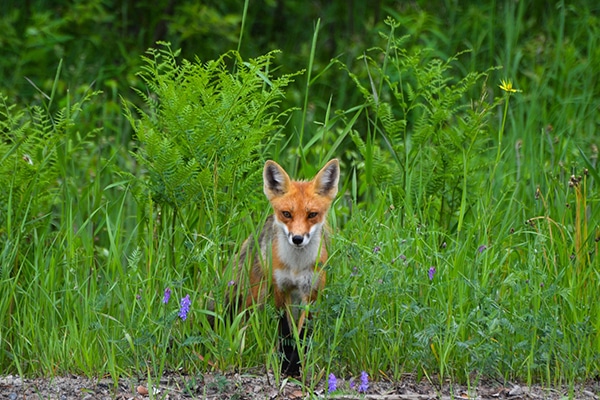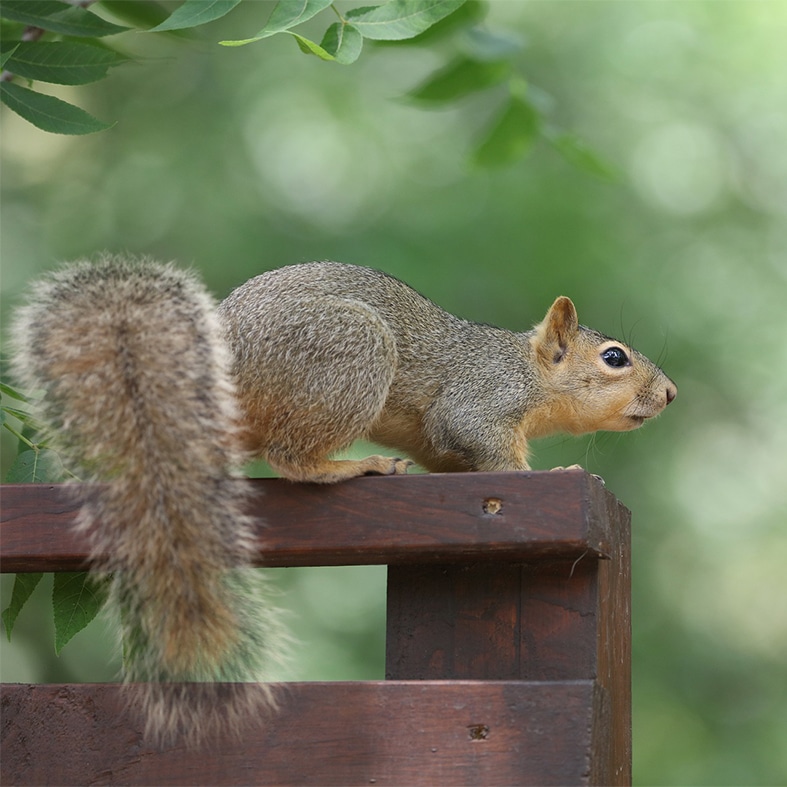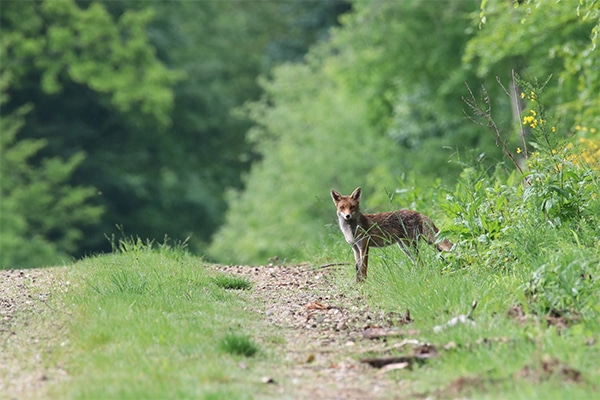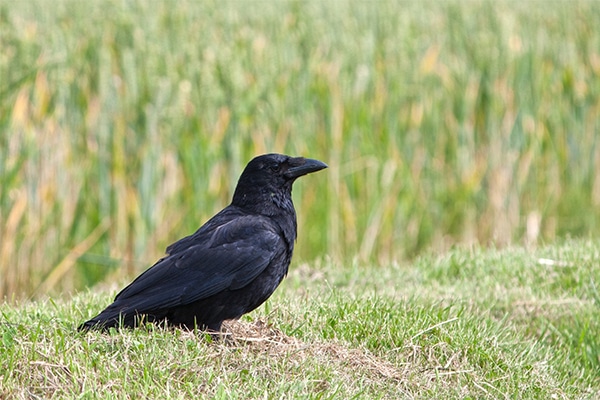
Best practice on the use of snares for fox control in England
This Code is aimed at those who carry out fox control in the English countryside to describe best practice when using snares.
Get information on the legal shooting season for mammals and birds in the UK.
Apply for funding for your project or make a donation today
Comprehensive information and advice from our specialist firearms team.
Everything you need to know about shotgun, rifle and airgun ammunition.
Find our up-to-date information, advice and links to government resources.
Everything you need to know on firearms law and licensing.
All the latest news and advice on general licences and how they affect you.


Home » Pest and Predator Control » Grey squirrel control with live capture traps
Our native red squirrel (Sciurus vulgaris) is at significant risk of being displaced by the introduced eastern American grey squirrel (Sciurus carolinensis). The larger grey squirrel can easily out-compete the red squirrel for resources, including food and habitat.
Across the UK, grey squirrels are known carriers of diseases such as the squirrel pox virus and the adenovirus. Squirrel pox virus is fatal to reds but causes no known harm to greys.
Where both species occur, the most effective means of conserving red squirrels is by reducing the number of grey squirrels. Greys also cause economic damage to timber crops, costing an estimated £10m, take birds’ eggs and damage bird and pheasant feeders. This guidance is intended to help you control grey squirrels in the most effective and humane way possible.
Grey squirrel control is a legal activity which does not need to be licensed. However, if trapping on land with a Site of Special Scientific Interest (SSSI) or Area of Special Scientific Interest (ASSI) designation, you may need consent from the relevant statutory conservation agency to kill or take away an animal. Although it is rare that consent is required for grey squirrels, we recommend that you check and gain confirmation before undertaking control on a SSSI.
The table below outlines the various laws relevant to the grey squirrel. The basic provisions of the legislation are that:
It is illegal to release a trapped grey squirrel into the wild or to keep a grey squirrel in captivity.
BASC’s Code of Practice on trapping pest mammals gives more information on the subject.
| Legal instrument | Provision |
| Wildlife and Countryside Act 1981 (as amended) – Northern Ireland Wildlife Order | Illegal to release, or to allow to escape, to the wild any captive grey squirrel |
| Wild Mammals (Protection) Act | Illegal to subject them to willful acts of cruelty or abuse |
| Destructive Imported Animals Act 1932 | It is an offence to keep a grey squirrel in captivity, except under a license |
Greys can be trapped at any time of the year but March to September is the best time due to a shortage of food. Later in the year, natural food, such as nuts and seeds, are more abundant and make trapping more difficult.
Trapping is a legally acceptable and most effective way of controlling grey squirrels in most situations.
A live capture trap must be used where red squirrels are present or suspected but, where there are no reds, a spring trap may be selected as the preferred method. We recommend reading BASC’s Code of Practice on trapping pest mammals for guidance on the use of spring traps.
Traps should be pre-baited for about five days before setting the trap. To pre-bait, secure the trap door open and bait with whole maize for a minimum of five days, preferably one or two weeks.
Spread the bait over an area of a few metres around the trap. After a few days, bait closer to the trap and put some inside the trap. It is not possible to distinguish between food eaten by red or grey squirrels in areas with both species.
However, only squirrels will remove the soft germ of the maize, discarding the outer kernel. This may give an indication that there are grey squirrels if red squirrels are known not to be present in the area.
After the pre-baiting period, if the food is being taken, set the trap (if not, move the trap to a new location and try again). Make sure it is covered and check that the trap mechanism works correctly. Place bait inside the trap behind the treadle plate to attract squirrels.
Once set, the trap should be checked at least once a day. If there are reds present, it is good practice to check more regularly to minimise the time any non-target species is in the trap. Non-target species, such as red squirrels or hedgehogs, must be released when you check the trap.
If you are not able to check the trap at least once a day, it should be closed until you are able to resume daily checking.
By law, certain species cannot be released back into the wild if caught. This includes mink which must be dispatched (please see BASC guide to best practice on mink control). Brown rats can be killed or released at your own discretion.
Sprung traps can often be identified from a distance as the door will be closed. However, as the location or cover of the trap may prevent this, you should always approach traps directly and calmly to avoid undue stress to any captive animal.
You should try to confirm the species present in the trap without touching the trap or with minimal disturbance to avoid distress to the captive animal. Non-target animals must be released immediately.
Open the trap door, keeping your fingers well away from the trapped animal. You could use a trapping comb to contain the animal whilst lifting the door. When the exit is clear stand behind the trap until the animal has left the area.
There are two main legal methods of dispatch:
Wear thick gloves to minimise risk of being bitten or scratched. Place a sack over the trapdoor end of the trap.
Hessian sacks can be used but clear sacks enable the operator to see where the head is when the squirrel is in the sack. Roll the sack lengthways to create a tunnel and kneel on it to ensure no gaps.
Open the trapdoor by using your gloved finger or a stick in the side of the trap and tilt the trap to encourage the squirrel out. If it is reluctant, blowing on its tail will sometimes help or you can use a trapping comb.
Once the squirrel is in the sack, roll the sack tightly to ensure the animal is at the far end of the sack and unable to move around. Locate the head and ensure it is not covered by the tail or excess bag.
This is more easily done if a clear plastic bag is used. Ensuring it is against a hard surface, using a heavy stick or a fishing priest, deliver a rapid blow of sufficient force to fracture the skull and thus destroy the brain, causing death.
If there is any doubt whether the blow was sufficient an additional blow must be administered.
This method should only be used by competent persons, confident in the use of weapons. We recommend that an airgun, rather than a firearm or shotgun, is used to dispatch the grey squirrel.
The animal must be kept still in the trap to allow for an accurate and humane despatch shot. This can be done using a trapping comb to push the animal to the end of the trap and lever it firmly against the side or roof of the cage.
It is advisable to prepare the weapon before doing this but do not load the gun until the squirrel has been restrained and release the safety catch only when you are ready to fire the shot.
Ensure the trap is on soft ground to minimise the risk of pellet deflection and make sure the squirrel’s head is clearly visible and not obscured by the tail. Hold the gun’s muzzle a few centimetres away from the head and fire.
A single shot should kill the grey squirrel. However, if a second shot is required take it as quickly and safely as possible, aiming at the junction of the skull and neck to destroy the brain stem.
It is your responsibility to ensure that whichever method used is delivered quickly, effectively and humanely. Death must be confirmed for each animal in all circumstances.
Signs of death include:
Once death is confirmed, the airgun should be unloaded and made safe if shooting has been the dispatch method.
As carrion can play an important part in forest ecosystems it may be acceptable to leave carcasses, distributed in suitable locations.
Overarching this, carcasses should be disposed of in accordance with current legislation and local bylaws, which may put additional requirements on top of legislation.
It is only necessary to disinfect traps if you are trapping in areas where there are red squirrels present. In these cases, using a disinfectant is essential in preventing the spread of disease between grey and red squirrels.
Disinfect the trap after it has been occupied. Spray with a solution of disinfectants such as Trigene or Virkon S and leave to dry. The trap can be left out in the rain to rinse away the odour of the disinfectant, which can sometimes discourage animals from entering the trap. Always follow the manufacturer’s safety instructions when using disinfectants.
Trapped animals will almost certainly urinate and defecate while in the trap and when trapping you may encounter rats or other rodents.
Weil’s disease or leptospirosis are serious and potentially fatal infections transmitted to humans by contact with urine from infected wildlife (especially rats) and farm animals. The bacteria can enter your body through ingestion, cuts and scratches.
Leptospirosis is an infectious condition that can cause a range of different symptoms such as mild flu-like symptoms or, in severe cases, result in multiple organ failure and internal bleeding that can result in death.
To prevent infection wear suitable gloves (ideally using barrier waterproof gloves under thick leather gauntlet style gloves) when handling traps, etc., and maintain good personal hygiene, i.e. washing hands regularly and before eating, drinking or smoking. Make sure your tetanus inoculation is up to date, too.
Eye protection and chemical-proof nitrile gloves should be worn when using disinfectants to clean traps and feeders. Eye protection may also be advisable when using an airgun to despatch animals.
Keeping a record of where your traps are and what success you have had is essential for both your own knowledge and for the assessment of any grey squirrel control network of which you are part.
We have produced a grey squirrel control recording form which records the key information.
Filling this in each time you move a trap or capture a squirrel is vital as you may not remember the details later.
Also, for shooting visits, recording each time you visit, even if you shoot nothing, allows the level of effort to be monitored.
It is important to share this information with any project you are working with if your efforts are to have the best value for wildlife conservation.
It will enable the project to analyse your results and provide feedback to other participants.

This Code is aimed at those who carry out fox control in the English countryside to describe best practice when using snares.

Foxes can be prolific predators of gamebirds, ground-nesting birds, small mammals and young livestock and need to be controlled.

Pest and predator control is an integral part of conservation and wildlife management and it is necessary to reduce predation and damage to acceptable levels.